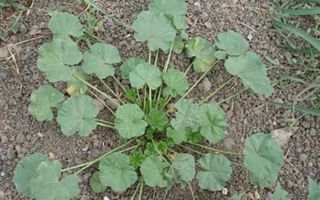Content
- 1 Description of mallow
- 2 Chemical composition
- 3 Useful properties of mallow
- 4 The use of mallow in traditional medicine
- 5 The use of mallow in cooking
- 6 Mallow harm and contraindications
- 7 Procurement and storage
- 8 Conclusion
The healing properties and contraindications of mallow is interesting to study for connoisseurs of home health recipes. A useful herb is good for colds and coughs, and is also suitable for culinary use.
Description of mallow
Mallow, or mallow, is a herb from the Malvov family. The stems of the culture are branched, up to 120 cm long, can be either straight or creeping. Taproot, thin, with numerous lateral branches. Leaves are round-heart-shaped with several lobes and a serrated edge, up to 6 cm in length, with bare or slightly pubescent sides. In color, the leaf plates of the mallow are rich green and bright.
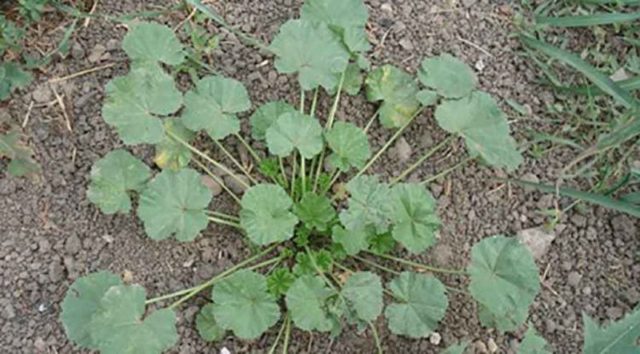
From July to August, the plant produces small whitish-pink buds. On the pedicels, they are located one by one, but at the same time the mallow is covered with inflorescences abundantly, therefore, in the middle of summer it becomes very decorative. At the end of flowering, fruits appear in place of the buds - schizocarps in the scientific language and "kalachiki" among the people. Both the fruits and other parts of the mallow are completely suitable for internal consumption, they do not possess poisonous properties.
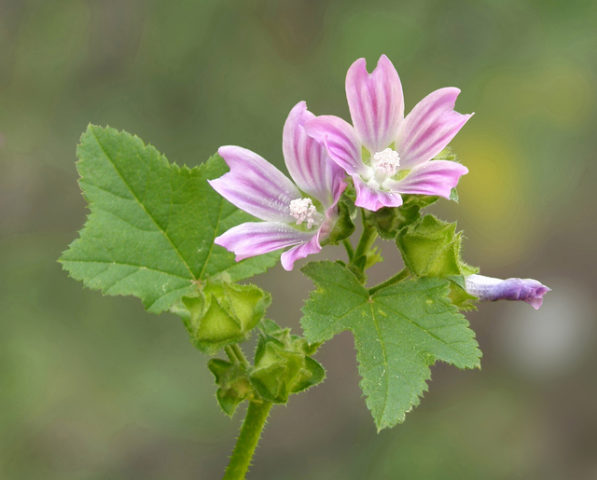
The homeland of the perennial is Central Asia, but now it grows almost all over the world. In Russia, you can see kalachiki in the Crimea and Krasnodar Territory, Siberia and the Far East, in the middle lane. Mostly mallow is found along roads and on wastelands, in parks and vegetable gardens.
Chemical composition
In folk medicine, the properties of mallow are appreciated due to the rich chemical composition. The leaves, stems and flowers of the plant contain:
- ascorbic acid and carotene;
- mucus;
- phenol carboxylic acids;
- terpenes and flavonoids;
- anthocyanins;
- tannins;
- mono- and disaccharides.
Malvin glycoside, a substance with mucolytic properties that is included in many expensive cough syrups, is of particular value in the malvinas composition.
Useful properties of mallow
Medicines based on a perennial plant:
- relieve inflammation in case of colds and infectious diseases;
- remove phlegm from the bronchi and lungs when coughing and severe respiratory ailments;
- eliminate skin irritations and rashes with dermatitis;
- accelerate tissue healing for burns and cuts;
- stop diarrhea and prevent dehydration;
- relieve chronic gastritis and pancreatitis;
- remove toxic substances from the body in case of poisoning;
- help to cope with diseases of the genitourinary system;
- relieve inflammation in the oral cavity and help with eye ailments.
The properties of mallow can be used for preventive purposes. Infusions and decoctions on the leaves of the plant strengthen the immune system and increase the body's defenses.
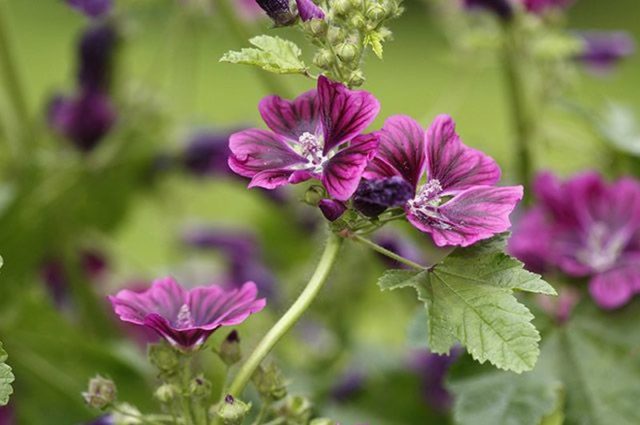
The use of mallow in traditional medicine
Home health recipes suggest using the beneficial properties of the kalachiki plant in both internal and external ways. The herb has very few contraindications, and it brings a healing effect quickly.
With bronchitis and angina
For the treatment of colds use the properties of leaves and flowers of mallow. With angina and dry cough, this infusion helps:
- 1 large spoonful of dry raw materials is poured with a glass of boiling water;
- kept under the lid for about 2 hours;
- filter and drink up to 4 times a day.
A single dosage of a useful infusion is 2 tablespoons, you need to take the product on an empty stomach. The properties of mallow soften the throat and promote the discharge of phlegm, eliminate hoarseness and hoarseness. The product is also suitable for rinsing with inflammation of the tonsils, the concentration can be increased and 2-3 large tablespoons of herbs can be brewed.
For healing wounds and burns
The beneficial properties of low mallow contribute to the rapid healing of the skin in case of damage. To treat burns, cuts and wounds, prepare the following infusion:
- 4 large tablespoons of dried herbs pour 500 ml of boiling water;
- keep under the lid for about 40 minutes;
- filter.
It is possible to use the properties of the infusion of mallow for lotions, a cotton pad dipped in the product is applied to sore spots for 15-20 minutes twice a day.
Another recipe suggests preparing a medicinal collection, namely:
- mix 10 g each of chamomile flowers, marshmallow root and sweet clover grass;
- add 30 g of flaxseeds;
- measure out 40 g of the healing mixture and pour boiling water in such a volume that a thick gruel is obtained.
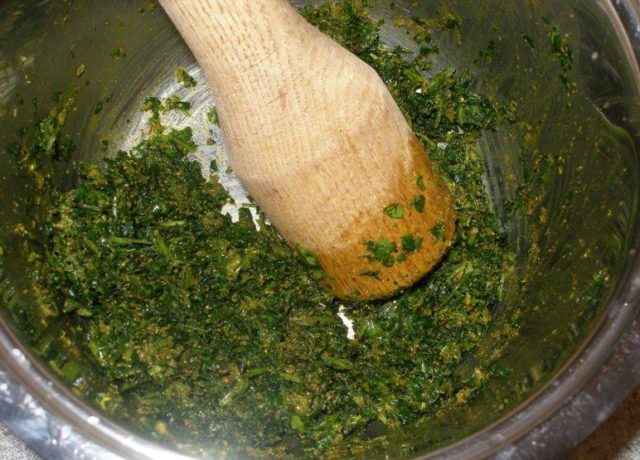
After that, the wet mixture must be wrapped in a piece of gauze and applied to the damaged area until the collection cools down.
It is possible to speed up the healing of injuries using the valuable properties of a strong mallow tincture. For its preparation, a glass of dry roots and leaves is poured into 1 liter of vodka and insisted for 2 days. Then the agent is filtered and the affected areas are wiped.
With diseases of the digestive tract
The green parts of the perennial mallow can help with pain in the stomach, intestines or liver, relieve constipation and bloating. There are several useful proven recipes.
Infusion on the leaves for gastritis and pancreatitis
To eliminate inflammation in the stomach and pancreas, the following remedy helps:
- 1 large spoonful of dried mallow leaves pour 1 liter of boiling water;
- keep it under a closed lid for an hour;
- filtered through cheesecloth.
You need to take a drink in half a glass half an hour before the main meal.
Infusion on the roots for bloating in the abdomen
With increased gas production, the properties of the plant roots have a good effect. The recipe looks like this:
- dried rhizomes of mallow are crushed in a volume of 2 large spoons;
- pour a glass of hot water;
- insist for 15 minutes and filter.
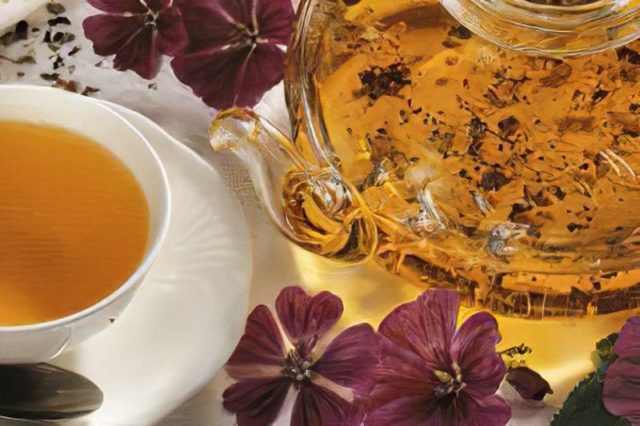
They drink a healing agent half a glass three times a day, first the infusion must be slightly warmed up.
Medicinal collection for intestinal colitis
A collection of several beneficial herbs helps to get rid of pain in the intestines and improve the condition of gastritis. Do it as follows:
- mix the mallow, chamomile and calendula in equal parts;
- pour 100 g of dry collection with a glass of hot water at about 80 ° C;
- cover and leave for 50 minutes.
It is necessary to drink the product, 150 ml twice or three times a day, warm.
Decoction of mallow flowers from constipation
The medicinal properties of the squat mallow can help not only with diarrhea, but also with constipation. To cleanse the intestines, you need to prepare such a useful broth:
- half a large spoonful of plant materials is poured with 250 ml of boiling water;
- keep the mixture in a water bath for 15 minutes;
- cool under the lid and filter.
You need to use the remedy up to 4 times a day, the effect of the medicinal properties of the broth occurs the very next day.
To improve immunity
With a weakened immune system and a tendency to colds, mallow tea is beneficial. It is necessary:
- pour 15 g of dried flowers in 250 ml of boiling water in a teapot;
- cover with a lid;
- leave for 5 minutes, and then pour into cups through cheesecloth or a special strainer.
With conjunctivitis
Mallow has strong anti-inflammatory properties and is safe for mucous membranes. Therefore, it can be used to treat conjunctivitis. Traditional medicine recommends preparing the following remedy:
- mix the crushed leaves, flowers and roots of mallow in equal amounts of 25 g;
- pour the raw material with 500 ml of boiling water and leave to infuse for 2 hours.
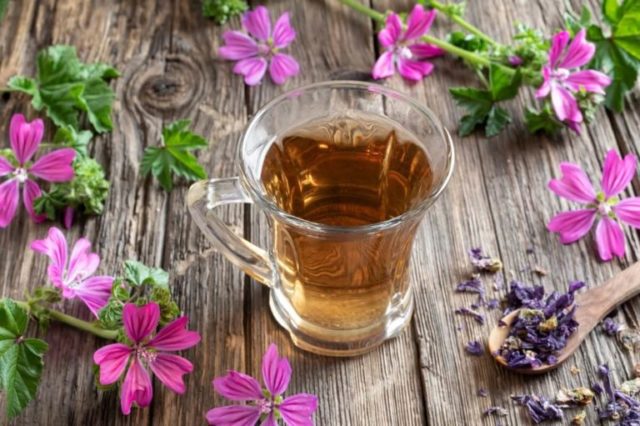
After the time has passed, the agent will need to be filtered from the sediment. After that, a cotton pad is moistened in the therapeutic liquid and the eyes are washed, the inflammation disappears in a few days.
The use of mallow in cooking
The properties of mallow herb are used not only in health recipes, but also in the kitchen. Soups are prepared from the leaves of the plant, they are added to cabbage rolls instead of cabbage, boiled and consumed together with feta cheese or hard cheese. The greens of the perennial plant are used in okroshka and improve the taste of regular scrambled eggs.
Mallow salad
Perennial leaves can be used to make a low-calorie, tasty and healthy salad. You will need the following ingredients:
- onions - 50 g;
- fresh leaves of mallow - 300 g;
- 100 g carrots;
- 50 g of horseradish and mayonnaise;
- dill, parsley and salt to taste.
The salad is made very simply - for 5 minutes the leaves of mallow are blanched in boiling water, and then cut and poured into a glass container. Chopped onions and carrots, grated horseradish are also added there. The salad is salted in accordance with one's own preferences, seasoned with mayonnaise, and decorated with dill and parsley on top.
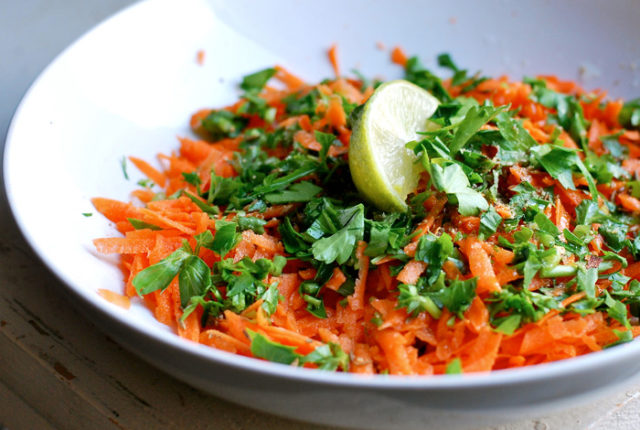
It takes very little time to prepare the dish - only about 10 minutes. And the benefits of the salad are significant, since it saturates the body with vitamins and minerals from vegetables and herbs.
Herbal mallow caviar
Fresh leaves of a perennial plant can be used to make unusual caviar. In the process, you will need additional ingredients, namely:
- nettle - 40 g of leaves;
- sorrel - 30 g;
- 2 small cloves of garlic;
- 25 g of onions;
- salt and black pepper to taste;
- 25 g tomato sauce and 15 ml olive oil.
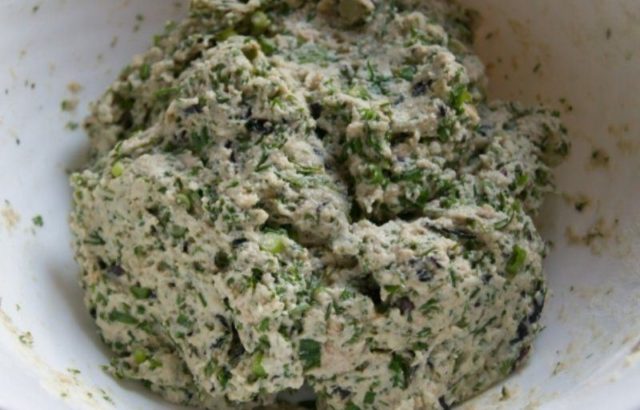
To prepare caviar, you must thoroughly rinse the leaves of the plants and blanch them for a minute. Then the greens are loaded into a blender and properly chopped, sautéed and onions are added. The whole mixture is poured with tomato paste and sprinkled with pepper and grated garlic and salt. At the last stage, the ingredients are sent to a saucepan or deep stewpan and stewed for another 15 minutes over the lowest heat.
Mallow harm and contraindications
The medicinal properties and contraindications of low mallow are related to each other. But in general, the plant does not contain toxic substances, and even with an overdose, it is quite difficult to encounter symptoms of poisoning. However, kalachiki is not recommended for use:
- with individual intolerance;
- during pregnancy and while breastfeeding;
- with a general tendency to allergic reactions.
For the first time, you need to try mallow with caution, this applies to both culinary dishes and drinks. If nausea, abdominal pain or skin irritation does not occur 3-4 hours after using the product, then the properties of a perennial plant can be used without fear.
Procurement and storage
For medicinal purposes, underground and aboveground parts of the plant are equally well suited, they have equivalent beneficial properties:
- The roots of mallow are collected in mid-spring, before the beginning of the flowering period, the perennial is dug out of the soil and the numerous shoots extending from the main stem are cut off. They will need to be rinsed and blotted with a paper towel, and then laid out to dry in a dry, but protected from direct sun place.
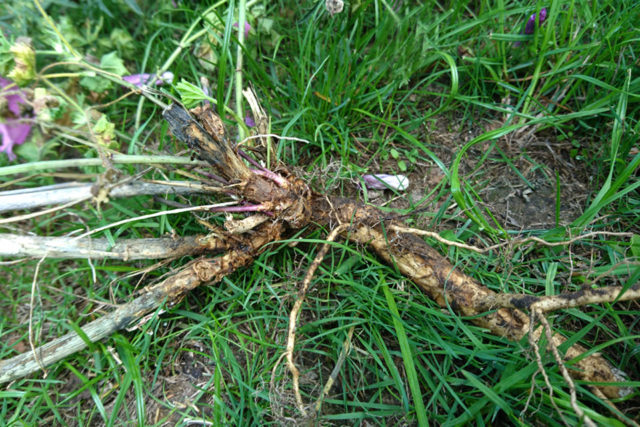 The main medicinal properties are possessed by the lateral roots of mallow
The main medicinal properties are possessed by the lateral roots of mallow - Flowers and leaves of mallow are harvested throughout the summer. It is best to collect raw materials in the morning, while there is no bright sun. After cutting, the greens and buds are rinsed with water, laid out on a flat surface in a thin layer and dried naturally in a place with good ventilation. After 1-2 days, the leaves and flowers must be transferred to a darkened room and wait until they dry completely.
 Mallow leaves and buds can be harvested all summer
Mallow leaves and buds can be harvested all summer
Store dried medicinal raw materials in fabric air-permeable bags in a dry place away from light. Subject to the rules, the mallow can retain beneficial properties for 3-5 years.
Conclusion
The medicinal properties and contraindications of the mallow complement each other. But in general, the medicinal plant is safe for consumption, provided that the dosages indicated in the recipes are observed.

